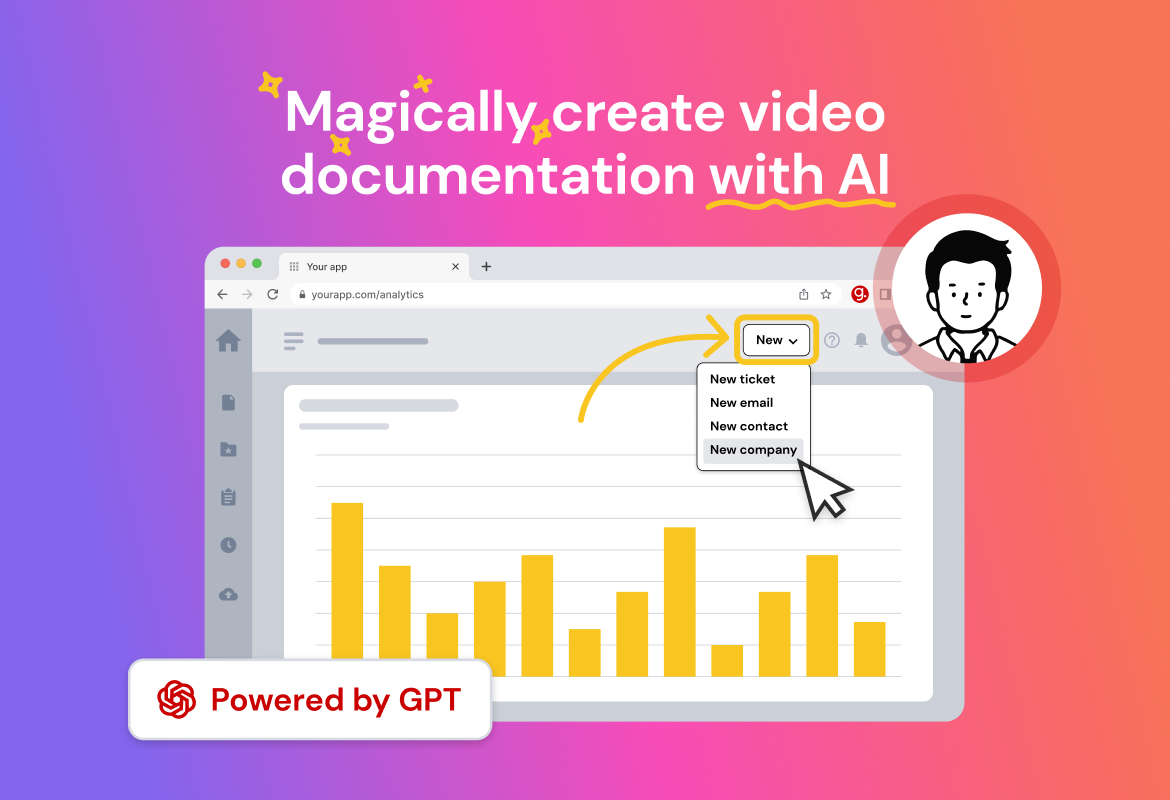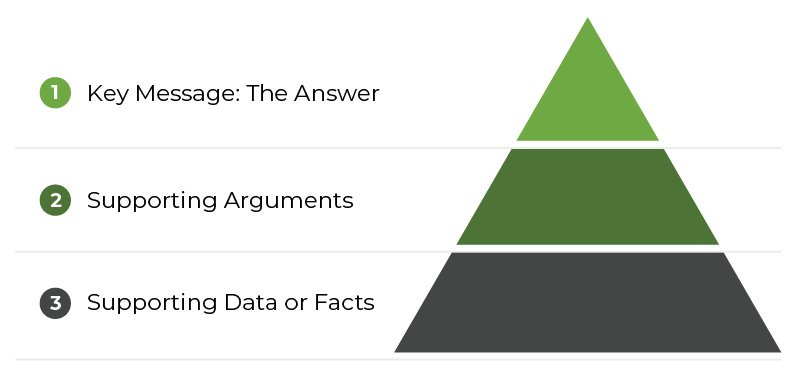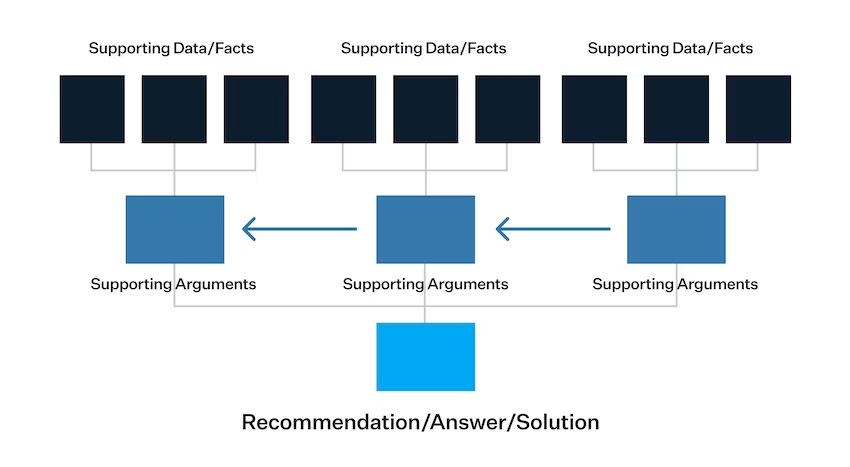👋 Hey, Kyle here! Welcome to The Influential Project Manager, a weekly newsletter covering the essentials of successful project leadership.
Today’s Overview:
How many times have you written an email at work, read it back and found that it didn't make as much sense as you'd hoped? Or worse, someone else has told you that they can't follow it. The Minto Pyramid Principle will show you how to communicate your ideas clearly and succinctly.
This framework, created by Barbara Minto, a former McKinsey & Company consultant, organizes communication hierarchically. At its core, it begins with your central message, then branches out into supporting ideas, and finally, ends with the detailed data.
In the context of construction project management, where complex concepts are the norm, the Pyramid Principle can be an essential daily tool. When crafting a message or document, lead with your conclusion, support it with key points, and then back up those points with detailed evidence.
Today’s Newsletter is Brought to You by guidde!
Tired of explaining the same thing over and over again to your colleagues?
It’s time to delegate that work to AI. guidde is a GPT-powered tool that helps you explain the most complex tasks in seconds with AI generated documentation.
Turn boring documentation into stunning visual guides.
Save valuable time by creating video documentation 11x faster.
Share or embed your guide anywhere for your team to see.
Simply click capture on our browser extension and the app will automatically generate step-by-step video guides complete with visuals, voice-over and call to actions.
The best part? The extension is 100% free.
🔺 The Minto Pyramid Principle
Filed under: Frameworks & Tools
Last year, I adopted a new structure to my communication, and the results were shocking.
My communication instantly became more clear and efficient.
This transformation is thanks to the The Minto Pyramid Principle, a method developed by Barbara Minto, a former McKinsey & Company consultant. Today, it’s a key tool for effectively conveying complex information in consulting, business, and government organizations.
The Minto Pyramid Principle organizes communication hierarchically. At its core, it begins with your central message, then branches out into supporting ideas, and finally, ends with the detailed data.
Imagine a pyramid: the wide base represents all the nitty-gritty details, and as you go up, the information gets consolidated into more general points, with the most important, overarching idea at the top.
In the context of construction project management, where complex concepts are the norm, the Minto Pyramid Principle can be an essential daily tool. When crafting a message or document, lead with your conclusion, support it with key points, and then back up those points with detailed evidence.
This method presents information in a top-down fashion, ensuring your main points are front and center. Begin with your conclusion to capture attention, then unpack the reasoning and data to reinforce your message.
By applying this principle to your business communications, including everything from emails to project reports, you can significantly enhance your clarity and effectiveness. Clear communication is often the hallmark of great leadership.
As demonstrated, I’ve led with the main idea: Clarity is king.
That’s the beauty of the Minto Pyramid Principle—getting straight to the point. Ready for a deeper dive? Let's explore how to master this tool for everyday use.
What is the Pyramid Principle?
While at McKinsey, Minto noticed that people, in general, were terrible at constructing compelling arguments. She also noticed that people have busy minds and their attention spans are limited.
Their arguments lacked structure and focused too much on presenting data and facts upfront. As a result, by the time they reached their final recommendation, the audience had already lost interest or become distracted by the details.
Minto realized that unlike how you usually tell a good story, where you build suspense by delaying the resolution of a key issue until the very end, in a business presentation context you should do the exact opposite: Lead with the answer.
Your colleagues or stakeholders don't need to be entertained; they're busy and want to get things done. So, the simple solution is to lead with the answer.
This is what is known as the Pyramid Principle:
Start with the recommendation/answer/solution upfront
Back up that recommendation with a handful of supporting arguments
Build trust in your arguments using supporting data
If you do this the structure of you argument ends up looking like a pyramid:
It's the exact opposite of what most of us are naturally drawn to — the upside-down-pyramid:
Most people, consciously or unconsciously, tend to use to the upside-down pyramid when presenting complex information. This is how we think and process information. We build up to a conclusion by first reciting all of the facts, recounting all of the analyses that have been done, or reviewing all of the supporting ideas. Then, we get to the punch line.
However, effective communication and thinking are not done in the same way. As Minto put it, "You think from the bottom up, but you present from the top down."
Applying the Pyramid Principle will enable you to present your thinking so clearly that the ideas move off the page and into the readers mind with minimum effort and maximum effect.
It’s time to bring your ideas to life!
Step 1: Lead with the Answer
In construction project management, time is of the essence, much like in consulting firms such as McKinsey, where the mantra is to "lead with the answer."
If a project stakeholder asks, "What is your solution to this problem?", a construction manager should promptly reply with, "We need to focus on X." State your conclusion first, then explain your reasoning if required.
Here’s why this method works well:
Saves Time: Stakeholders often juggle numerous tasks and value concise communication. They want to grasp the essentials rapidly. If you present your main point right away, you can capture their interest immediately, and they may agree without further details.
Focuses on Core Objectives: Executives and senior project leaders look for solutions that align with the project's primary goals. By leading with your main suggestion, you cater to their preference for focusing on key strategies, rather than getting bogged down in details.
Increase Influence: A clear, direct recommendation reflects confidence. When you assert your proposed action decisively, you come across as more convincing and authoritative.
Step 2: Supporting Arguments
After presenting your conclusion, be prepared with supporting arguments. These are the facts and rationale that reinforce your main point.
Several types of supporting arguments can be used to strengthen a case. These include:
Data and Facts: Leverage concrete numbers such as project timelines, cost estimates, or material quantities to substantiate your recommendations.
Supporting Evidence: Reference relevant studies, such as structural assessments or workflow analyses, which can provide empirical backing to your main points.
Logical Reasons: Use clear, straightforward reasoning that connects directly to project goals—like how a particular building method aligns with your efficiency objectives.
Financials and Performance Metrics: Show how your proposal stands up financially by discussing budget implications, ROI, or performance metrics, such as expected improvement in construction timelines or reduction in waste.
Step 3: Supporting Data and Facts
Solid evidence is essential to back up your main point and make your argument convincing. Facts, stats, and real-world examples like case studies give weight to your ideas and show they work in practice.
Examples of supporting data and facts include:
Market Analysis: Use specific construction market trends or needs analysis to justify a new building project or the adoption of a new construction method.
Project Case Studies: Cite examples of similar construction projects that succeeded due to a similar approach or solution, emphasizing the outcomes relevant to your current project.
Client Testimonials: Share feedback from past projects where clients or end-users have benefited from your management or construction strategies, linking their satisfaction to your proposal.
Financial Projections: Provide cost-benefit analyses, budget forecasts, or financial impacts to showcase the economic advantage or cost savings of your recommended actions.
Final Thoughts
To wrap things up, remember that clear communication is the key to success, especially in project management.
The Pyramid Principle keeps things simple yet impactful: start with your main idea, then lay out the supporting points and evidence like a well-structured blueprint. It’s straightforward, no-frills, and gets results.
As project managers, you’re the bridge between vision and reality. Adopting this principle means your team gets the clarity they need, decisions are made faster, and projects stay on track.
Give it a try, and you'll see how it streamlines your communication and brings your ideas to life!
Until next week,
Kyle Nitchen

Whenever you're ready, there are 5 ways I can help you:
Get my first book! No Bullsh*t Project: A Project Manager’s Guide to Successful Project Leadership
Upgrade your scheduling software. Experience the future planning system for construction and real estate development. iPM subscribers can enjoy a 15% discount on first year license.
Get my full toolbox (free). Access 30+ software and hardware tools I'm using today.
Learn Takt Planning. Elevate your skills as a scheduler, planner, and lean builder with the Takt Planning & Control online course. Use code "Influentialpmtakt" for 30% off.
Advertise in my newsletter. Put your brand in front of 5,700+ construction project managers, leaders, and execs. (Booked out 8 weeks)








Leading with the conclusion or key message is very effective in science communications too.
Great advice! Thanks Kyle!